Watercubs & Kivisilmän
working show-quality newfoundlands
Photos: http://watercubs.kuvat.fi/kuvat/Events%20%20Tapahtumat/Bettinas%20New%20Zealand%20trip/
A trip to the other side of the world for water rescue work, Easter 2012 - written by Bettina Salmelin
Everything
started when Bettina Salmelin got to know Fiona Robertson (Newflands).
Fiona was planning a European tour and was interested in joining us for
water rescue trainings. As it happened, the same weekend Fiona was
planning to stay in Belgium, we had our annual swimming pool trainings
(for trainers) and a lecture training seminar weekend (theory for
handlers) held by Karel Mennes. Fiona was positively impressed about
the trainings and decided to place an invitation for me to tome to New
Zealand to hold some water rescue camps. New Zealand is made up of
islands surrounded by sea, but yet water rescue is only starting to
make baby steps ahead. It would be important for the trainer to be able
to guide the trainings in the right direction so that hopefully
somewhere in the not so distant future, there would be the possibility
of incorporating lifeguard dogs on beaches.
The trip sounded absolutely fabulous and during the following winter
holidays the flights were booked. I would be spending four weeks over
Easter 2012 working at local farms (deer, bulls, cattle and horses)
during the weeks to get credited for animal husbandry extra mural
studies as a part of my veterinary degree. The weekends I would spend
training dogs. I was to stay at Fiona's guest bedroom and the flight
expenses would be covered by the entry fees. In total I held three
one-day water rescue camps (trainings in the morning and afternoon,
with a lecture at midday) and I was invited to hold a raw feeding
seminar at a local raw feeding shop.
Bettina and some of the 1st day participants
The water rescue camp entries were limited to ten dogs to be able to
allow individual attention to every dog. The camp was full the first
and last day (sea), and half full the last (lake). The structures,
working dog temperaments and swimming abilities were about the same as
what you'd normally see in Europe. The biggest difference between NZ
training and normal European training is that they mostly train in sea.
The sea water is easier for the dogs as it gives a lot of buoyancy. I
was very surprised at what a huge difference it really does make in the
dogs. Dogs that are used to swimming in the sea were not as good
swimmers in lake water as they tended to swim much lower and their
swimming power was weaker. This made me think back to the proper
Newfoundland conformational structure as Newfoundland is also
surrounded by salty sea water. Could the modern Newfoundland structure
be more traditional that what is commonly thought as their swimming
techniques only improve with the aid from water buoyancy.
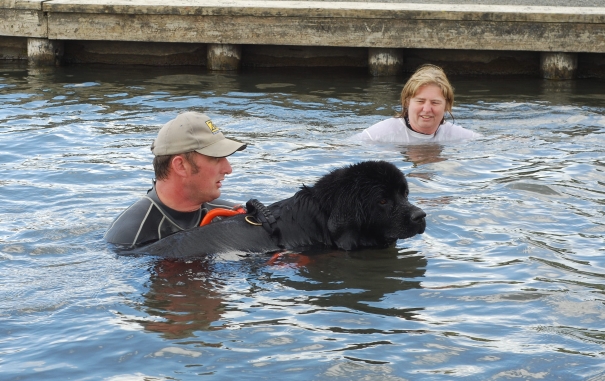
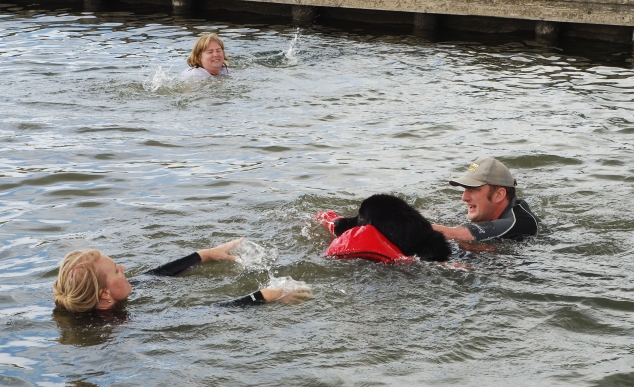
The participants practiced holding the dog still in water - and saving
two people at the same time
The water rescue trainings were modifications on the basic saving
people (and multiples), taking objects out and retrieving the boat. The
most interesting (and suprisingly also well completed) exercises were a
"call off" where you throw a toy, send your dog and call your dog back
before he reaches it, and jumping from the boat and fetching a roat
from the shore back to the boat. We also did a lot of variations and
scenarios, for example tossing a life jacket, boat, drowner and an oar
into the water and asking the participants to "solve" the scenario.
This was a lot of fun, and seemed to be very productive at teaching the
participants to think up of new exercises when they were asked to
contruct similar scenarios for the others in the group.
Hopefully they will all take this skill to their own trainings.
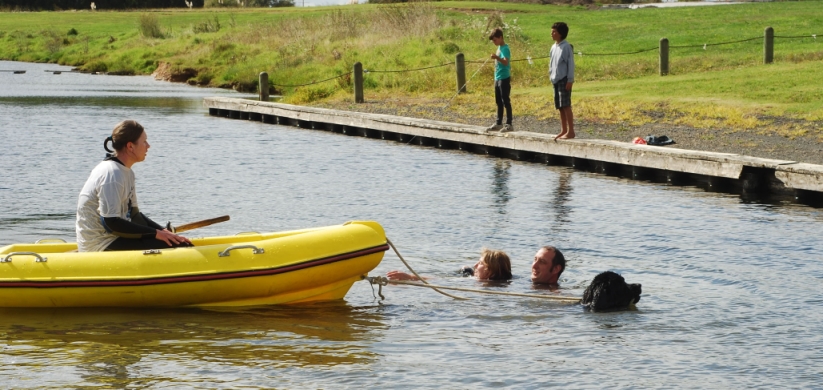
Saving the drowner and retrieving the boat
The waterwork midday lectures covered basic training, new ILS K9 team lifesaving regulations and general notes on how to set up your own trainings. The local newspaper came to make a front-page coverage about the camps :-).
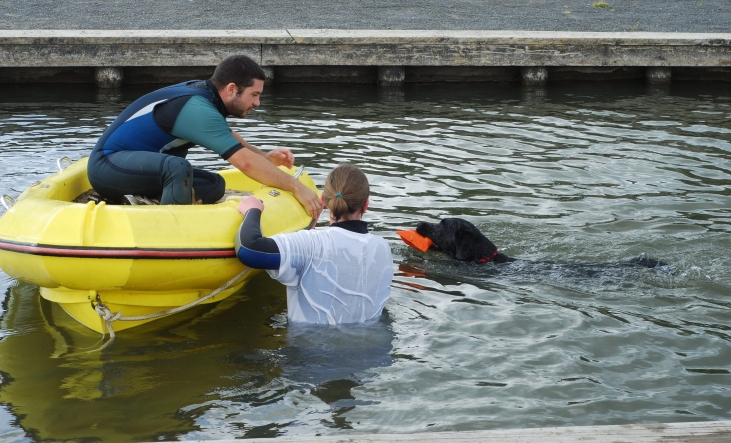
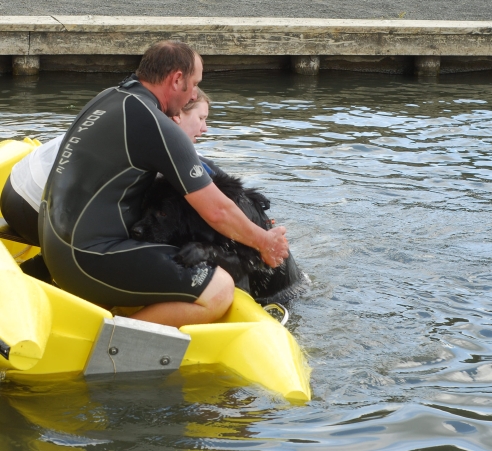
Take out - Learning how to lift the dog back into the boat.
In addition to the camps I had the opportunity to go and follow the
Kiwi Newfoundland Club's trainings after the first two camps. They were
planning on having a test day, but the instructors were so
enthousiastic about the exercises we covered during the camps that they
would rather continue and train those exercises. The cub secretary had
even written down all the exercises in detail which we had covered
during the camp (about 14-ish per day per group), and that's what they
were training :-). I was extremely proud to have had such success with
the trainings :-).
Kiwi Newfoundland trainings
I talked with the group and got to find out that the tests are much
more relaxed than what they normally are in Europe. During the test day
as long as the participant successfully completes the exercises in a
set class, the judge will sign it off and the participant can move to
the next class. It's not a question of counting points or seconds.
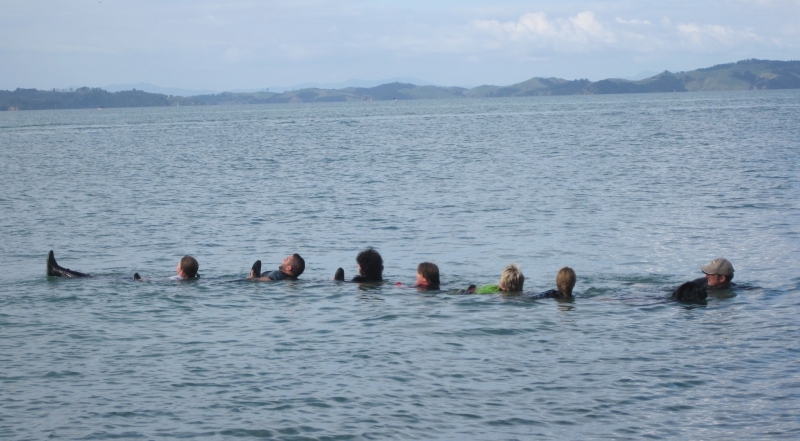
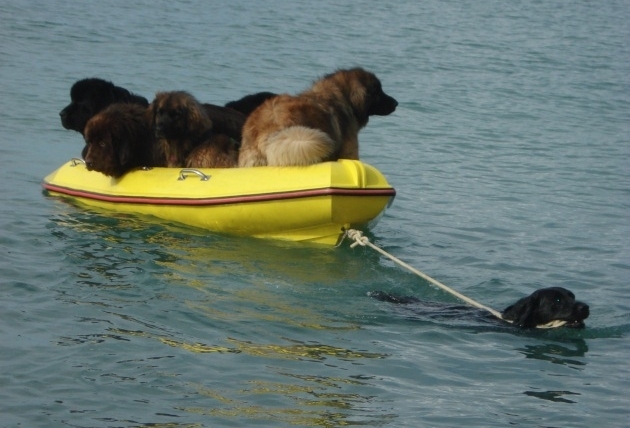
During the last day we did some fun exercises: a newf saving six people - and a lab pulling some leonbergs and newfs
In addition to all the waterwork I had the opportunity to go to three
shows. The shows were outdoor drive-in shows, with approximately 500
entries per day, divided between four judges. There were between 3-5
newfs. During the same day there can be even two shows, which was
surprising to hear. The classes were the ordinary ones apart from an
additional "New Zealand bred" class, and no champion class. It does
take six CACs to become a champion, but due to the small entry numbers,
it is usually relatively easy. The biggest difference between NZ and
Finnish (or European) shows is that best of sex class winners also
competed in the group rings. For example the "best intermediate in
group" and "best intermediate in show" were also chosen. The prizes
were usually dog food or towels, very unlike the trophies we are used
to. The winners received a long ribbon with the dogs' name and placing
written on.
During the non-working, non-training days I managed to get a few days
of "touristy stuff". The trips included for example a trip to see the
dolphins and the whales just out of Auckland city. It was amazing the
see the animals in the wild, follow how during their feeding they push
the fish to the surface and how the dolphins, whales and birds all work
together.
Auckland - Dolphins
Sealife working together: dolphins, whale and birds pushing the fish to the surface
I also travelled past the Lord of the Rings Hobbitton and all the way up Mount doom (Mount Ruapehy).
Mount Ruapehu
I had the opportunity of traelling down the Coramandel coast and sticking my bare feet into the "hot water beadh" sand. There are still active volcanoes and hot springs in New Zealand: one of them went accross the beach. It was also amazing to just jump out of the car: get undressed and jump into almost a boiling hot river.
Hot Water Beach - Coramandel coast
Coramandel coast
We also travelled to see old and still working gold mines. In one of the gold mines there were "glow worms": worms that have a glowing head and produce a silk-like netting to trap flies into.
Glow worm
We also visited the Wai-O-Tapu and Orakei Korako volcanoareas: the colours were amazing!
Orakei Korako - Wai-O-Tapu
During the car
trips I saw a lot of wild turkeys. After talking with the farmers I got
to know that there is no turkey farming in New Zealand, only wild
turkeys (and too many of them!).
Wild turkeys
All in all the trip was absolutely fabulous. I received another
invitation to come back next year (and I hope to do so), with perhaps
extending the trip to also visit the Australian water rescue dogs. Lets
see how I'll have the time to do so as for example this upcoming summer
is already planned full on water rescue camps in the US and hopefully
also some of our own puppy news :-). Even though the four week trip was
definitely worth it, at least by the end I did start missing our own,
and working with them, my own dogs, in the water.
Black sand beach - The blue lagoon
Scenery
Water Rescue Camps in New Zealand - recap written by Phill Moore & Lela newf
(c) Salmelin